Northeast
Mexico:
From Thornscrub to Cloudforest, an Introduction to Mexico
Forthcoming Departures:
12-23 March 2007 (12 days)
$TBA per person from Harlingen
Single Supplement: $TBA
3-14 December 2007 (12 days)
$TBA per person from Harlingen
Single Supplement: $TBA
6-17 December 2008 (12 days)
$TBA per person from Harlingen
Single Supplement: $TBA
*Scroll down for the Mexican
Plateau and South Texas
Extension.
Besides being home to many of Mexico’s
endemic birds, Northeast Mexico
boasts at
least ten avian taxa found nowhere else! This
tour offers participants an opportunity to encounter
seven of these
(another two can be seen on the extension) while traveling through
habitats as
diverse as Gulf Coastal Plain, dry upland oak forest, gallery forest,
and humid
montane subtropical forest (cloudforest). States
visited will include San Luís Potosí, Tamaulipas,
Hidalgo, and Veracruz.
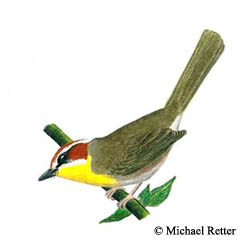 Day
1: Harlingen. You
we be greeted after your flight arrives
at Valley International Airport
in the U.S. state of
Texas. We
will spend the night in Brownsville. Day
1: Harlingen. You
we be greeted after your flight arrives
at Valley International Airport
in the U.S. state of
Texas. We
will spend the night in Brownsville.
Day 2: Border
Crossing. After taking care of
paperwork, we will drive south through Matamoros. In
transit we should see birds like Brown Jay
and Tamaulipas Crow—our first Northeastern endemic.
As we approach the Ciudad Mante area, we will
stop to bird some gallery forest along the way. Birds
present here include Rose-throated Becard, Elegant
Trogon, Red-crowned
Parrot, wintering Louisiana Waterthrush, and our first member of the
tropical Furnariid family: Ivory-billed
Woodcreeper. This will be our first
night spent in Cuidad Mante.
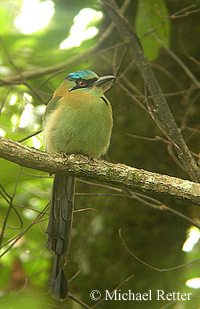 Day 3:
Below
Gómez
Farías. Today we will concentrate
on the
tropical areas on the road below the town of Gómez Farías. In the fields here we hope to see grassquits, seedeaters, Gray-crowned Yellowthroat, and
the resident flock of Double-striped Thick-knees. A
short cruise up the Río Frío may produce a Muscovy
Duck, an Amazon Kingfisher, a pair of Masked Tityras, or even a
Sungrebe if
we’re lucky! As we explore the
forest,
flocks
of White-crowned Parrots and Yellow-winged Tanagers offer a taste of
what’s to
come. Night in Mante. Day 3:
Below
Gómez
Farías. Today we will concentrate
on the
tropical areas on the road below the town of Gómez Farías. In the fields here we hope to see grassquits, seedeaters, Gray-crowned Yellowthroat, and
the resident flock of Double-striped Thick-knees. A
short cruise up the Río Frío may produce a Muscovy
Duck, an Amazon Kingfisher, a pair of Masked Tityras, or even a
Sungrebe if
we’re lucky! As we explore the
forest,
flocks
of White-crowned Parrots and Yellow-winged Tanagers offer a taste of
what’s to
come. Night in Mante.
Day 4: Above
and
around Gómez Farías. As we
continue up
the road towards the village
of Alta Cima and
the El
Cielo Biosphere Reserve, some of the
birds possible include Fan-tailed Warbler, Mountain Trogon,
Crested Guan,
Bronze-winged Woodpecker, and the Northeast Mexican endemic coeruliceps
race of Blue-crowned
Motmot—the only one with a blue crown! Night
in Mante.
Day 5: The Tula-Ocampo Road. Today we’ll drive west up into the mountains
in order to explore some new habitats. The
humid, brushy upper slopes on the Gulf slope of the
divide provide
habitat for some hard-to-see skulkers: Blue
Mockingbird, Crimson-collared Grosbeak, and Rufous-capped Brushfinch. On the inland slope, the avifauna changes
drastically as we decend into desert scrub. Vermillion
Flycatchers abound, as Canyon Towhees chatter
and Lesser
Goldfinches tinkle. A visit to a
reservoir should produce a nice variety of ducks, some grebes and
shorebirds,
and perhaps a surprise or two. Night in
Mante.
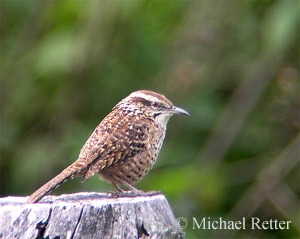 Day 6:
Above
El
Naranjo. We start the day driving south
and west to bird above El Naranjo, concentrating on the road to El
Maguey de
Oriente. Here we’ll spend a good deal of
time with mixed flocks that contain birds such as Crescent-chested
Warbler,
White-winged Tanager, Rufous-browed Peppershrike, and Olivaceous
Woodcreeper. With some luck, we’ll come
across a pair of Gray-collared Becards—a curiously uncommon and nomadic
Mexican
endemic. Carefully checking the
understory here is probably our best chance at finding a Thicket
Tinamou, Blue
Ground-Dove, or a pair of the vocally-stunning Singing Quail. After supper, we’ll do a voluntary run back
to the El Maguey road to look for Tamaulipas Pygmy-Owl.
Night in El Naranjo. Day 6:
Above
El
Naranjo. We start the day driving south
and west to bird above El Naranjo, concentrating on the road to El
Maguey de
Oriente. Here we’ll spend a good deal of
time with mixed flocks that contain birds such as Crescent-chested
Warbler,
White-winged Tanager, Rufous-browed Peppershrike, and Olivaceous
Woodcreeper. With some luck, we’ll come
across a pair of Gray-collared Becards—a curiously uncommon and nomadic
Mexican
endemic. Carefully checking the
understory here is probably our best chance at finding a Thicket
Tinamou, Blue
Ground-Dove, or a pair of the vocally-stunning Singing Quail. After supper, we’ll do a voluntary run back
to the El Maguey road to look for Tamaulipas Pygmy-Owl.
Night in El Naranjo.
Day 7: Agua
Zarca. Today we continue
birding above El Naranjo,
this time concentrating on the xeric upland oak forest near Agua Zarca. This habitat supports a disjunct population
of the highly-social Spotted Wren. Other
birds we may run across here include Pale-billed Woodpecker,
Azure-crowned
Hummingbird, Elegant Euphonia, Spot-crowned Woodcreeper, Bat Falcon,
and
Military Macaw. In the afternoon we will
descend to the old falls at El Salto. The
patchy remnant forest here is very similar to lowland
tropical
rainforest, and we have a chance to see both species of ant-tanager. Just downstream is the beautiful cascade at
El Meco. The hedgerows on the way may
produce Lineated Woodpecker, Yellow-headed and Red-crowned Parrots, and
Squirrel Cuckoo, while the cascade itself is often the site of a
pre-roost
performance by White-collared Swifts. Night
in El Naranjo.
 Day 8:
To
the
Cloudforest! After some early-morning
birding above El Naranjo, we’ll head toward Tlanchinol, in Hidalgo state. Tlanchinol offers the most northerly
accessible patch of true cloudforest in the Americas. Common birds here include the ubiquitous
Common Bush-Tanager, the beautiful Chestnut-capped Brush-finch, the
spritely
Golden-browed Warbler, and the incredibly skulking Tawny-throated
Leaftosser. We will do some late afternoon
birding after
unpacking at our hotel in Huejutla de Reyes. Night in Huejutla. Day 8:
To
the
Cloudforest! After some early-morning
birding above El Naranjo, we’ll head toward Tlanchinol, in Hidalgo state. Tlanchinol offers the most northerly
accessible patch of true cloudforest in the Americas. Common birds here include the ubiquitous
Common Bush-Tanager, the beautiful Chestnut-capped Brush-finch, the
spritely
Golden-browed Warbler, and the incredibly skulking Tawny-throated
Leaftosser. We will do some late afternoon
birding after
unpacking at our hotel in Huejutla de Reyes. Night in Huejutla.
Day 9: Tlanchinol. Today we will spend the entire day birding
the trail to the pueblito of Lontla, mainly concentrating on mixed
flocks. The flocks are dominated by
bush-tanagers,
Brown-capped Vireos, Crescent-chested Warblers, and boreal migrant
warblers
including Hermit, Townsend’s, Black-and-white, and Black-throated Green. Keeping an ear out here should help us to
detect some larger birds like Unicolored and Azure-hooded Jays, Emerald
Toucanets, and Strong-billed Woodcreepers. There
is a chance of encountering one of the
most endangered and least-known birds in Mexico:
the highly-endemic Bearded Wood-Partridge.
Night in Huejutla.
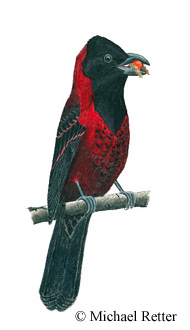 Day
10: Tlanchinol. We
will begin this morning at first light,
hoping to catch of a glimpse of birds as they come out to feed on the
wide
trail. Black and White-throated Robins,
Black-headed Nightingale-Thrush, and even Scaled Antpitta have been
observed
doing this here. Later on, we’ll bird
the scrubby second-growth on the trail off of km marker 169. Birds of note here include Gray
Silky(-flycatcher), Hooded Grosbeak, White-bellied Emerald, and two
eastern highland
endemics—White-naped Brushfinch and Hooded Yellowthroat.
Night in Huejutla. Day
10: Tlanchinol. We
will begin this morning at first light,
hoping to catch of a glimpse of birds as they come out to feed on the
wide
trail. Black and White-throated Robins,
Black-headed Nightingale-Thrush, and even Scaled Antpitta have been
observed
doing this here. Later on, we’ll bird
the scrubby second-growth on the trail off of km marker 169. Birds of note here include Gray
Silky(-flycatcher), Hooded Grosbeak, White-bellied Emerald, and two
eastern highland
endemics—White-naped Brushfinch and Hooded Yellowthroat.
Night in Huejutla.
Day 11: Back
to the U.S. Today we drive north to Texas
via the coastal route through Veracruz. Though we may be headed home, there is still
birding
to be done! Flooded fields in coastal
Tamaulipas often yield impressive numbers of waterfowl, like Mottled
Duck and
Ross’s Goose. Stopping at some ponds, we
hope to see Northern Jaçana
and Mangrove
Swallow. Night in Harlingen.
Day 12: Departure. Today
you will catch your flight home.
CLIMATE: Generally
temperate, however, it can be cold at upper elevations in the
morning. Though it’s the dry season, it
may be muddy at Tlanchinol. The first
couple
mornings of the extension will likely be quite cold.
DIFFICULTY: Moderately
easy. The trails
at
Tlanchinol are moderately steep, but only for short stretches, and they
are taken very slowly, while
birding.
ACCOMODATION:
Quite comfortable.
Mexican
Plateau and South Texas
Extension (4 days)
Forthcoming Departures:
8-11 March 2007 (4 days)
$TBA per person from Harlingen
Single Supplement: $TBA
29 November - 2 December 2007 (4 days)
$TBA per person from Harlingen
Single Supplement: $TBA
2-5 December 2008 (4 days)
$TBA per person from Harlingen
Single Supplement: $TBA
After a brief morning of birding
in Texas,
we will cross the border at McAllen,
and drive west to the
Monterrey-Saltillo area. We'll bird the dry
plateau along the Nuevo León-Coahuila border in search of the
highly-endemic and little-known
Worthen's
Sparrow. Along the way we may encounter
Phainopepla, Phyrrhuloxia, Scaled Quail, and Ferruginous Hawk. The remaining time will be spent in Texas, looking for Rio Grande Valley
specialties like White-collared Seedeater, Green Parakeet, Audubon’s
Oriole,
and Brown Jay. We will concentrate any
vagrants, which sometimes show up this time of year.
CLIMATE: Generally
temperate, but this time of year a
norte can bring brisk temperatures. Expect chilly dawns at
high elevations in Mexico.
DIFFICULTY: Easy.
Almost all walking is done on trails or roads.
ACCOMMODATION:
Quite comfortable.
For more
information, contact Michael Retter at mlretter AT yahoo.com
BACK |
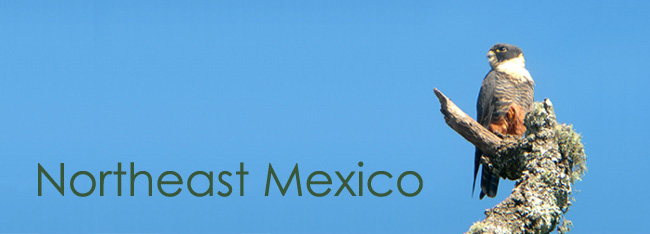
 Day
1: Harlingen
Day
1: Harlingen Day 3:
Below
Gómez
Farías. Today we will concentrate
on the
tropical areas on the road below the town of
Day 3:
Below
Gómez
Farías. Today we will concentrate
on the
tropical areas on the road below the town of  Day 6:
Above
El
Naranjo. We start the day driving south
and west to bird above El Naranjo, concentrating on the road to El
Maguey de
Oriente. Here we’ll spend a good deal of
time with mixed flocks that contain birds such as Crescent-chested
Warbler,
White-winged Tanager, Rufous-browed Peppershrike, and Olivaceous
Woodcreeper. With some luck, we’ll come
across a pair of Gray-collared Becards—a curiously uncommon and nomadic
Mexican
endemic. Carefully checking the
understory here is probably our best chance at finding a Thicket
Tinamou, Blue
Ground-Dove, or a pair of the vocally-stunning Singing Quail. After supper, we’ll do a voluntary run back
to the El Maguey road to look for Tamaulipas Pygmy-Owl.
Night in El Naranjo.
Day 6:
Above
El
Naranjo. We start the day driving south
and west to bird above El Naranjo, concentrating on the road to El
Maguey de
Oriente. Here we’ll spend a good deal of
time with mixed flocks that contain birds such as Crescent-chested
Warbler,
White-winged Tanager, Rufous-browed Peppershrike, and Olivaceous
Woodcreeper. With some luck, we’ll come
across a pair of Gray-collared Becards—a curiously uncommon and nomadic
Mexican
endemic. Carefully checking the
understory here is probably our best chance at finding a Thicket
Tinamou, Blue
Ground-Dove, or a pair of the vocally-stunning Singing Quail. After supper, we’ll do a voluntary run back
to the El Maguey road to look for Tamaulipas Pygmy-Owl.
Night in El Naranjo. Day 8:
To
the
Cloudforest! After some early-morning
birding above El Naranjo, we’ll head toward Tlanchinol, in
Day 8:
To
the
Cloudforest! After some early-morning
birding above El Naranjo, we’ll head toward Tlanchinol, in  Day
10: Tlanchinol. We
will begin this morning at first light,
hoping to catch of a glimpse of birds as they come out to feed on the
wide
trail. Black and White-throated Robins,
Black-headed Nightingale-Thrush, and even Scaled Antpitta have been
observed
doing this here. Later on, we’ll bird
the scrubby second-growth on the trail off of km marker 169. Birds of note here include Gray
Silky(-flycatcher), Hooded Grosbeak, White-bellied Emerald, and two
eastern highland
endemics—White-naped Brushfinch and Hooded Yellowthroat.
Night in Huejutla.
Day
10: Tlanchinol. We
will begin this morning at first light,
hoping to catch of a glimpse of birds as they come out to feed on the
wide
trail. Black and White-throated Robins,
Black-headed Nightingale-Thrush, and even Scaled Antpitta have been
observed
doing this here. Later on, we’ll bird
the scrubby second-growth on the trail off of km marker 169. Birds of note here include Gray
Silky(-flycatcher), Hooded Grosbeak, White-bellied Emerald, and two
eastern highland
endemics—White-naped Brushfinch and Hooded Yellowthroat.
Night in Huejutla.